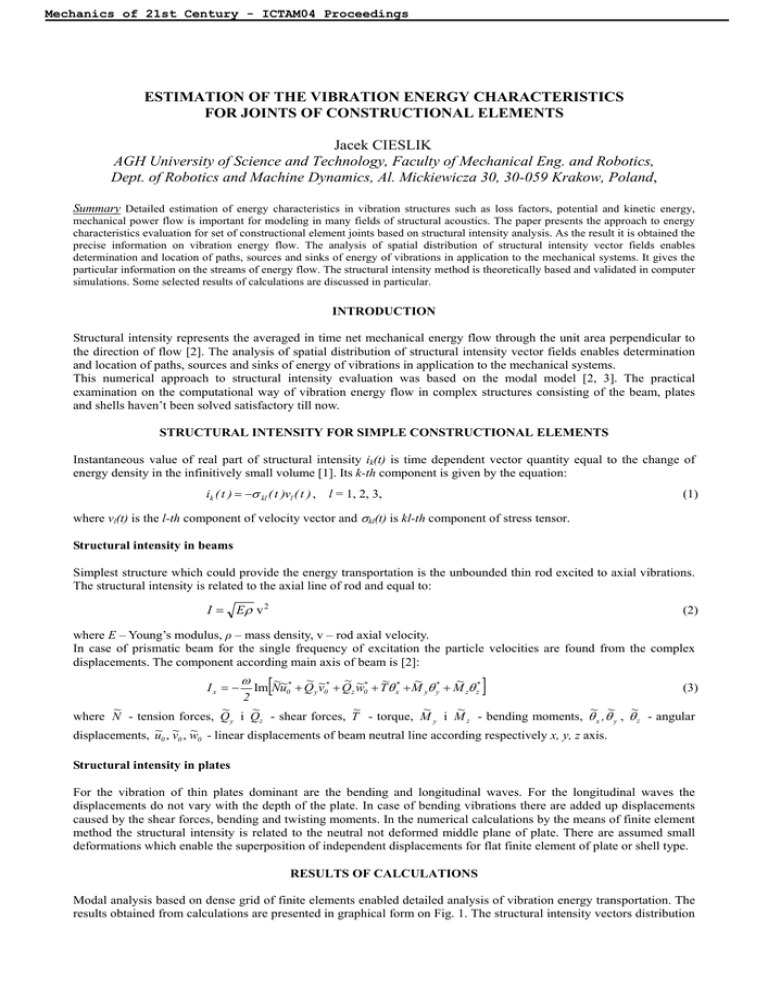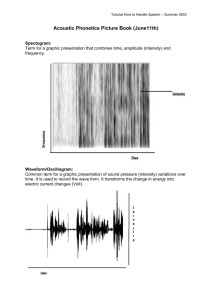Jacek CIESLIK ESTIMATION OF THE VIBRATION ENERGY CHARACTERISTICS
advertisement

Mechanics of 21st Century - ICTAM04 Proceedings ESTIMATION OF THE VIBRATION ENERGY CHARACTERISTICS FOR JOINTS OF CONSTRUCTIONAL ELEMENTS Jacek CIESLIK AGH University of Science and Technology, Faculty of Mechanical Eng. and Robotics, Dept. of Robotics and Machine Dynamics, Al. Mickiewicza 30, 30-059 Krakow, Poland, Summary Detailed estimation of energy characteristics in vibration structures such as loss factors, potential and kinetic energy, mechanical power flow is important for modeling in many fields of structural acoustics. The paper presents the approach to energy characteristics evaluation for set of constructional element joints based on structural intensity analysis. As the result it is obtained the precise information on vibration energy flow. The analysis of spatial distribution of structural intensity vector fields enables determination and location of paths, sources and sinks of energy of vibrations in application to the mechanical systems. It gives the particular information on the streams of energy flow. The structural intensity method is theoretically based and validated in computer simulations. Some selected results of calculations are discussed in particular. INTRODUCTION Structural intensity represents the averaged in time net mechanical energy flow through the unit area perpendicular to the direction of flow [2]. The analysis of spatial distribution of structural intensity vector fields enables determination and location of paths, sources and sinks of energy of vibrations in application to the mechanical systems. This numerical approach to structural intensity evaluation was based on the modal model [2, 3]. The practical examination on the computational way of vibration energy flow in complex structures consisting of the beam, plates and shells haven’t been solved satisfactory till now. STRUCTURAL INTENSITY FOR SIMPLE CONSTRUCTIONAL ELEMENTS Instantaneous value of real part of structural intensity ik(t) is time dependent vector quantity equal to the change of energy density in the infinitively small volume [1]. Its k-th component is given by the equation: ik ( t ) = −σ kl ( t )vl ( t ) , l = 1, 2, 3, (1) where vl(t) is the l-th component of velocity vector and σkl(t) is kl-th component of stress tensor. Structural intensity in beams Simplest structure which could provide the energy transportation is the unbounded thin rod excited to axial vibrations. The structural intensity is related to the axial line of rod and equal to: I = Eρ v 2 (2) where E – Young’s modulus, ρ – mass density, v – rod axial velocity. In case of prismatic beam for the single frequency of excitation the particle velocities are found from the complex displacements. The component according main axis of beam is [2]: Ix = − ω 2 [ ~ ~ ~* ~ * ~ * ~ * ~ Im Nu~0* + Q y v~0* + Qz w 0 + T θ x + M yθ y + M zθ z ] (3) ~ ~ ~ ~ ~ ~ ~ ~ ~ where N - tension forces, Q y i Qz - shear forces, T - torque, M y i M z - bending moments, θ x , θ y , θ z - angular ~ - linear displacements of beam neutral line according respectively x, y, z axis. displacements, u~ , v~ , w 0 0 0 Structural intensity in plates For the vibration of thin plates dominant are the bending and longitudinal waves. For the longitudinal waves the displacements do not vary with the depth of the plate. In case of bending vibrations there are added up displacements caused by the shear forces, bending and twisting moments. In the numerical calculations by the means of finite element method the structural intensity is related to the neutral not deformed middle plane of plate. There are assumed small deformations which enable the superposition of independent displacements for flat finite element of plate or shell type. RESULTS OF CALCULATIONS Modal analysis based on dense grid of finite elements enabled detailed analysis of vibration energy transportation. The results obtained from calculations are presented in graphical form on Fig. 1. The structural intensity vectors distribution Mechanics of 21st Century - ICTAM04 Proceedings over the flat elements of rectangular frame structure is shown. In region far from connections, external damping or excitation the directions of vectors are ordered, parallel and steady regarding the vector magnitude and direction. There are clear seen the very specific disturbances of vectors distribution in places of element connections. In places close to the connections it can be observed the circulation of a structural intensity vectors. This effect means the circulation and conservation of vibration energy in the mechanical system. In some cases the directions of vectors are focused in small volume. This inclines to the conclusion that is the place of vibration energy dissipation – energy loss caused by the transmission of waves through the connection of elements. The particular analysis leads to conclusion that intensity vectors distribution by its nature enables localization of vibration energy decay in large surface elements. a) b) Fig. 1. Distribution of structural intensity vectors for connection of flat elements: a) longitudinal connection of two flat bars, b) perpendicular connection of two flat bars The distribution of structural intensity vectors gives the qualitative characteristic of vibration energy transportation in mechanical systems. Additional measure in form of integral of magnitude structural intensity vector component perpendicular to the certain closed surface e. g. element cross section enables the quantitative assessment of energy transfer paths and its balance in the structure. CONCLUSIONS Presented method of structural intensity vector calculation enables its evaluation for chosen frequency range and mode shapes [2]. Structural intensity is the product of stress and velocity for the same point of the structure. Shown dependencies connect the structural intensity with linear and angular displacements, forces and moments exerted to the structures like beams, plates and shells. The method of structural intensity evaluation is based on calculation of displacements in nodes and stresses in inner points i.e. Gauss points of finite elements. The calculations are done on complex modal parameters counted by the use of the numerical modal analysis based on FEM. The disadvantage of the method is its poor convergence. The number of modes which are used in calculation process should be properly chosen. The abrupt changes of stress which occur in regions close to the excitation or discontinuities of structure can not be well described by the limited number of lower modes. This makes the problem of calculation method exactitude. The method of analysis of structural intensity distribution has been applied as a new diagnostic method for assessment of failure which could occur in constructional elements. It enables the investigation in the regions of high concentration of vibration energy flow which consequently are exposed to the risk of damage. It can be considered as the identification of the regions of increased damping of vibrations. Examples of examination of structural intensity distribution in elements of rectangular frame have confirmed the method usability to the investigation of vibration energy transportation paths and places of its concentration in discontinuities. The method enables the qualitative analysis depending on structural intensity vectors distribution. Also there are possible the quantitative analysis based on calculated values of power of vibrations in particular elements of structure. References [1] Gavric L.: Influence of local modifications on energy flow in thin-walled structures. Ph.D. Thesis 1991, Universite de Technologie de Compiegne, Compiegne. [2] Gavric L., Pavic G.: A finite element method for computation of structural intensity by normal mode approach. Journal of Sound and Vibration, 1993. Vol 164(1), 29-43. [3] Cieślik J.: Vector fields of structural intensity in application to analysis of vibrational energy flow. Archives of Transport, Vol. 15, (1) 2003. [4] Cieślik J.: Vibration energy flow in rectangular plates. Journal of Theoretical and Applied Mechanics. Vol. 41, (4) 2003 r. [5] Cieślik J.: Intensity vector fields in application to vibrational energy flow. Conference Proc. CMM-2003 – Computer Methods in Mechanics, June 3-6, 2003, Gliwice, Poland, s.105-106. << session << start






